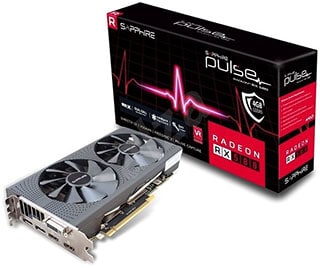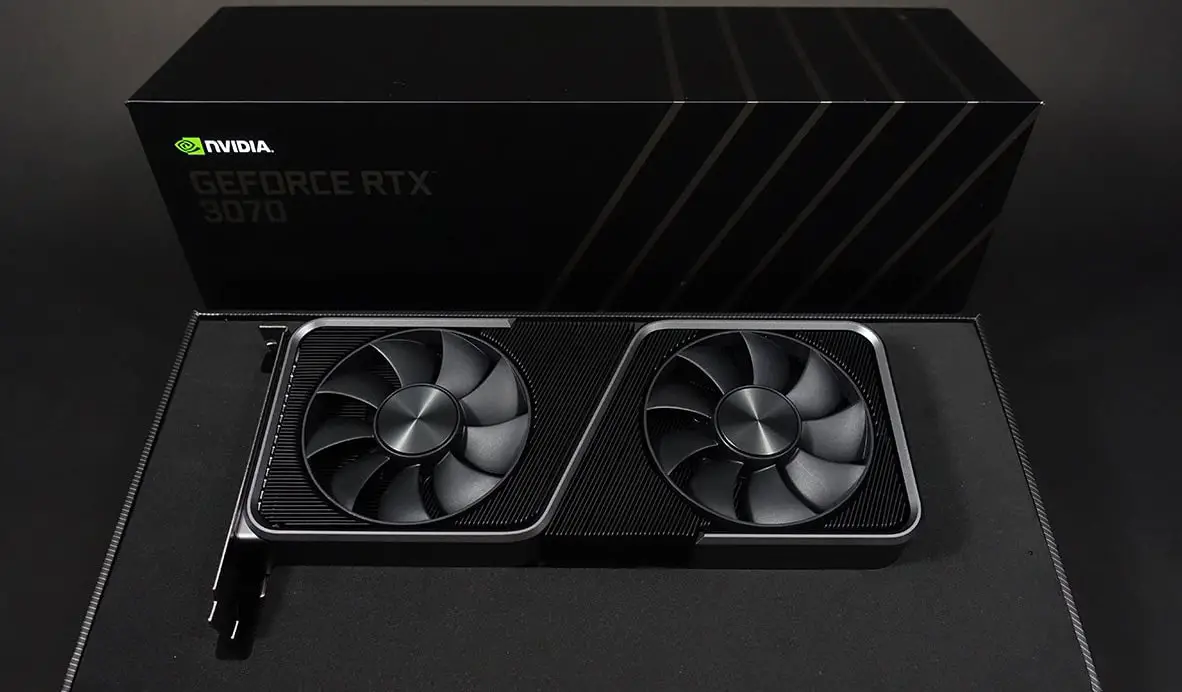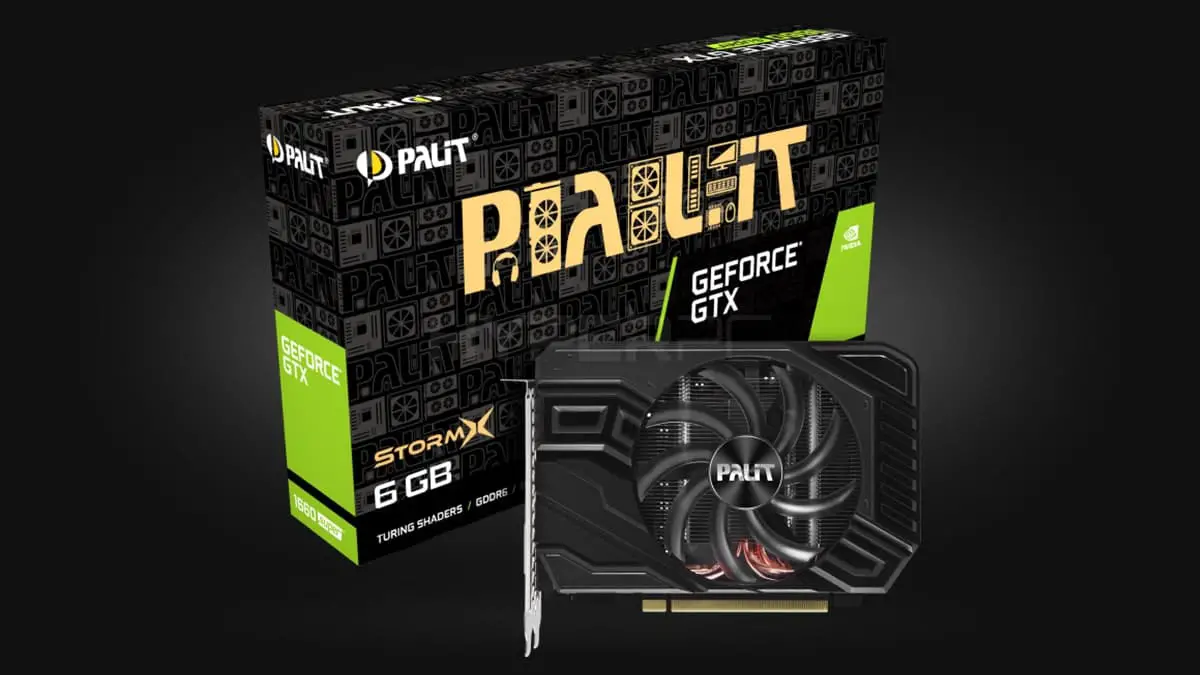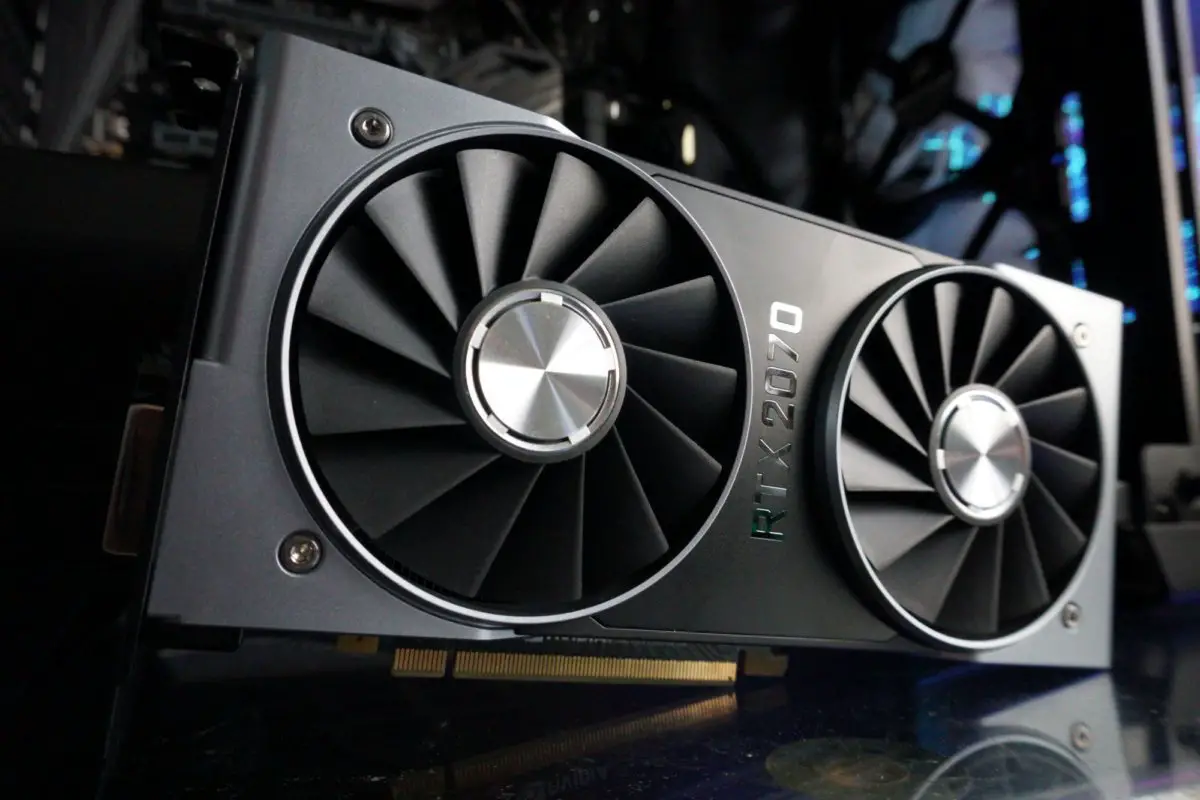SAPPHIRE Radeon RX 580 8 GB: Review| Benchmark| Overclocking| Hashrate| Settings: We present to your attention a review of the AMD Radeon RX 570 video card in mining on various algorithms. The first GPU we’ll talk about is the Sapphire NITRO + Radeon RX 580 Limited Edition. This is one of the best RX 580 models from Sapphire. It has a higher clock speed (factory setting) than most other RX 580 GPUs , and has additional components such as spare fans.
The model has improved cooling compared to the Sapphire RX 480 NITRO +. And of course the new model has a higher price tag. The new RX 580 cards, which look a lot like last year’s Sapphire RX 480s, will now be called PULSE. Let’s take a look at the characteristics.
Note that, taking into account the current prices for video cards, in 2020 cloud GPU mining became the most profitable, which is much more profitable than buying your own equipment, much more flexible in the amount of investment and does not require maintenance of your farms. We have made a detailed review about cloud mining of cryptocurrency , within which we have compiled a rating of the best services based on the results of the last three years.
The main characteristics of the RX 580 graphics card :
- 2304 stream processors
- 14 nm. FinFET, fourth generation Graphics Core Next (GCN)
- 1450 MHz clock frequency with GPU overclocking capability
- 8192 MB GDDR5 memory, 256-bit memory bus, 2000 MHz RAM clock
- Display outputs: 1x DL-DVI-D, 2x HDMI 2.0b, 2x DisplayPort 1.4
- Updated Dual-X 95mm fans with two ball bearings
- Power connectors: 1x 6-pin PCI-E, 1x 8-pin PCI-
- Power consumption: 225 W
- Dual UEFI BIOS
The new and larger cooler is a welcome improvement, as are the spare fans for the RX 580 NITRO + LE. RX 580 non Limited and RX 570 NITRO + are now equipped with the same new coolers.
Another notable difference is the use of an additional power connector in the NITRO + RX 5 × 0 series, which have one 6-pin and one 8-pin PCI-E connector. An additional power connector is required due to higher clock speeds and, as a consequence, due to increased power consumption. For miners, this can be a problem if they want to connect 6 such cards on one farm and to one power supply. Note that the PULSE series will have one, not two PCI-E power connectors.
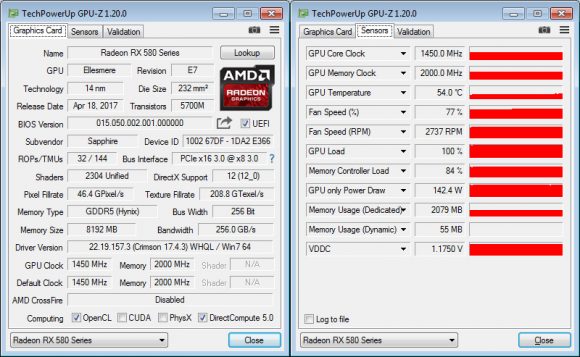
What does the GPU-Z spec say? The GPU clock generator works great at 1450 MHz and allows a little overclocking to 1500 MHz. Of course, this is not much. The increase in clock speed requires an increase in operating voltage to 1.1750V, which also results in an increase in power consumption to over 140W (for Power Draw, according to GPU-Z).
Ethereum Mining Performance with Ethash Algorithm
The video memory operates at a frequency of 2000 MHz, and here I would like to see Samsung GDDR5, tk. We are talking about the top model among the RX 580 from Sapphire and the limited edition. Unfortunately, Sapphire decided to install Hynix memory. Therefore, performance will no longer be optimal for algorithms such as Ethash (Ethereum) or Equihash (Zcash), where memory usage is very intensive.
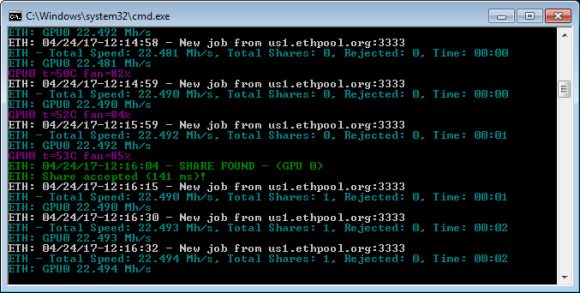
And now for the benchmarks containing some of the popular algorithms currently used by the most profitable miners. Using the latest Claymore Dual ETH miner , we get around 22.5 MHS from SapphireNITRO + Radeon RX 580 Limited Edition.
A disappointing result when you consider the use of all possible settings. Due to the use of Hynix (2000 MHz), the timing diagrams are relaxed, apparently again in order to maintain a higher operating frequency. If used Samsung GDDR5 it might be better. But Sapphire didn’t do it …
A similar and not very successful result can be seen in mining ZEC with the Claymore ZCash AMD GPU Miner 12.4 processor, but as you know, the Equihash algorithm is more memory intensive. The average data transfer rate for ZCash (ZEC) with this graphics card is about 296 H / sec.
The reason for such a low data transfer rate may be the same Hynix memory, or it may be due to a new AMD driver (with RX 500 support). And the official AMD Radeon Crimson ReLive Edition 17.4.3 driver (also for the RX 500) is apparently not very efficient for cryptocurrency mining.
Here are some more benchmark results for our Sapphire NITRO + Radeon RX 580 Limited Edition card:
rn rnt
- DCR: 1,202 GHS;
- XMR: 600 H / sес.;
- LBC: 0,165 GHS;
- PASC: 0.830 GHS;
- SIB: 8.2 MHS.
In terms of optimization, you can experiment with memory lines and get better results. In addition, lowering the GPU clock from a higher value (default) will also lower the voltage and achieve lower power consumption. This is especially true for optimizations for ETH, although the ZEC will require a slightly higher voltage (and clock speed).
Some miners also report that the RX 580 LE board can work fine on one 8-pin PCI-E connector. But to see for yourself, again you need to optimize the frequency and voltage to avoid power overload.
What are the conclusions? The Sapphire NITRO + Radeon RX 580 Limited Edition, while appealing to miners, is clearly designed for gamers. The overclocking option is more suitable for gaming. Miners, on the other hand, may like the large cooler and additional fans in the package. But two power connectors and increased power consumption are not something that can please.
The tuning margins of the RX 580 LE are a bit disappointing, but you can see some variation on performance / power consumption (the same results could be obtained by tuning the RX 580 or even the RX 570).
Hashrate RX 580 8gb in ETH + DCR mining
The first screenshot shows the performance of the RX580 8GB video card with a core frequency of 1150MHz with a BIOS mod optimized for dual ether mining and decree . With these lower core frequencies, the video card outputs 30 Mh / s on air + 1000MH / s on decree. Used miner from Cliemore version 9.
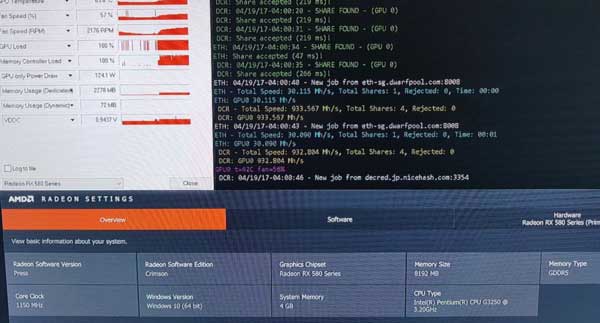
On the second video card RX580 8Gb, ETH mining was launched at stock settings with a result of 24.5 MH / s.
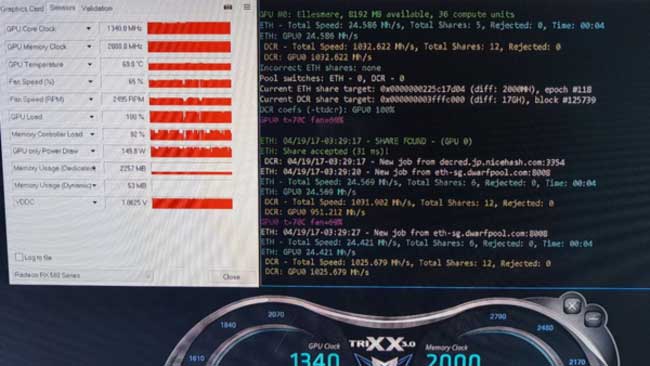
From the data obtained, we can conclude that the performance of the new RX 580 graphics cards does not significantly exceed the performance of the previous generation RX 480. But since the RX 480 has long been out of stores, the RX 580 will be an excellent choice, the most optimal that AMD Radeon has to offer.
Overclocking Radeon RX 580 8 GB
RX 580 BIOS firmware
RX 580 Specifications Overview vs. RX 480
| Model: | Radeon RX 580 | Radeon RX 480 |
| Retail price: | 25 550 rubles | from 19 600 rubles |
| Technical information | ||
|---|---|---|
| GPU: | Polaris 20 | Polaris 10 |
| Tech process: | 14 nm | 14 nm |
| Number of transistors: | 5.7 billion | 5.7 billion |
| GPU clock speed (base): | 1.257 MHz | 1.120 MHz |
| GPU clock speed (Boost): | 1.340 MHz | 1.266 MHz |
| Memory frequency | 2.000 MHz | 2.000 MHz |
| Memory type | GDDR5 | GDDR5 |
| Memory | 4 / 8 GB | 4 / 8 GB |
| Memory bus width | 256 pages | 256 pages |
| Memory bandwidth | 256 GB / s | 256 GB / s |
| DirectX version | 12 | 12 |
| Stream Processors | 2.304 | 2.304 |
| Texture blocks | 144 | 144 |
| Raster Operations Pipelines (ROP) | 32 | 32 |
| Pixel fill rate: | 42,88 GPixel/s | 40,512 GPixel/s |
| Texture fill rate: | 192,96 GTexel/s | 182,304 GTexel/s |
| Computational performance: | 6,125 TFLOPS | 5,833 TFLOPS |
| Typical power consumption: | – | 150 watts |
| SLI/CrossFire | CrossFire | CrossFire |
The Radeon RX 580 relies on the Polaris 20 GPU, which is architecturally the same as the Polaris 10 GPU. However, the process has been optimized, hence the new name. AMD set the base frequency and Boost at 1.257 and 1.340 MHz. The partners’ video cards will have even higher clock speeds, they can exceed 1.400 MHz.
The Radeon RX 580 graphics card is equipped with 4 or 8 GB of video memory. But we recommend taking the 8 GB version so that performance does not rest on the amount of memory. The video memory is connected via a 256-bit interface. The clock speed is 2.000 MHz, so the bandwidth reaches 256 GB / s. Note the 36 CUs, 2,304 stream processors, 144 texture units, and 32 raster operations pipelines (ROPs).






